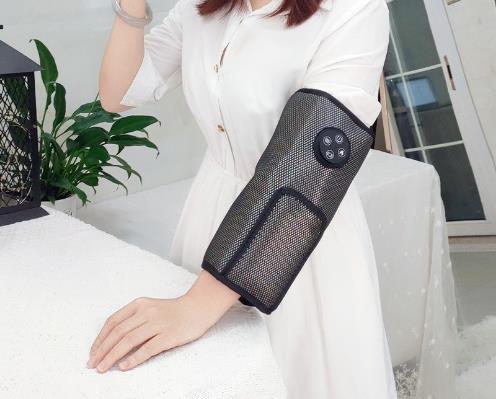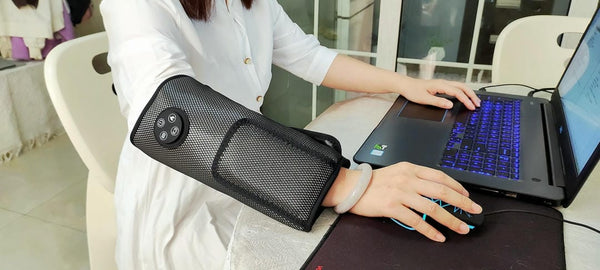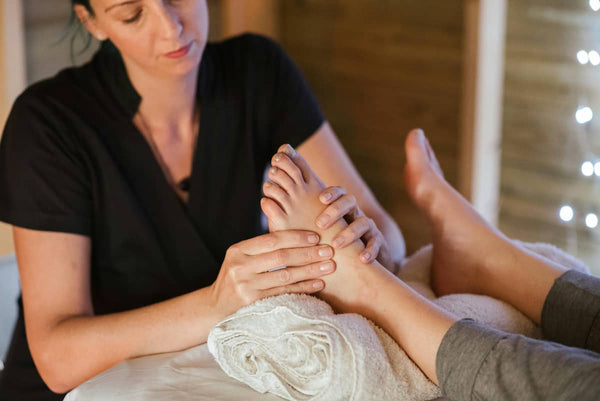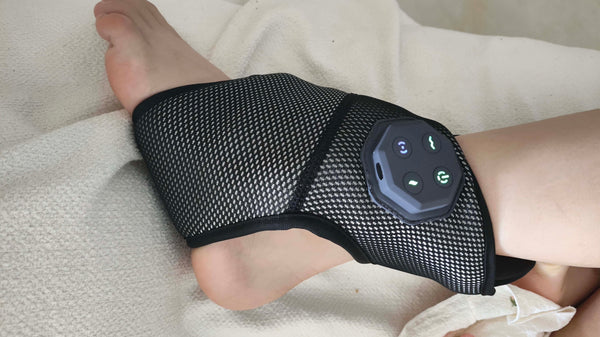 Lower back pain is an unwelcome guest for many, especially office workers chained to their desks or individuals nursing sports injuries. It can range from a dull ache to sharp, debilitating pain, significantly impacting daily life. In the quest for relief, many turn to tools like massage guns, a potent form of electric lumbar massager. These percussive devices, as a specific category of electric lumbar massager, have surged in popularity, promising deep tissue massage at your fingertips. But when it comes to the sensitive lower back, a critical question arises: is it actually safe? As a consultant for family health product selection, I've seen the rise and potential pitfalls of such devices. This article will rationally explore the safety of using massage guns for lower back pain, helping you avoid potential harm and make informed choices.
Lower back pain is an unwelcome guest for many, especially office workers chained to their desks or individuals nursing sports injuries. It can range from a dull ache to sharp, debilitating pain, significantly impacting daily life. In the quest for relief, many turn to tools like massage guns, a potent form of electric lumbar massager. These percussive devices, as a specific category of electric lumbar massager, have surged in popularity, promising deep tissue massage at your fingertips. But when it comes to the sensitive lower back, a critical question arises: is it actually safe? As a consultant for family health product selection, I've seen the rise and potential pitfalls of such devices. This article will rationally explore the safety of using massage guns for lower back pain, helping you avoid potential harm and make informed choices.
The allure of a quick fix from an electric lumbar massager like a massage gun is strong, but the lower back is a complex structure. We need to look beyond the marketing and understand both the potential benefits and, more importantly, the risks. This is especially true given the varied advice and user experiences out there. Let's delve into what you need to know before you point that percussive head towards your lumbar region.
What is Lower Back Pain in Office Workers and Athletes?
For office workers, lower back pain often creeps in due to prolonged sitting, poor posture, and inadequate ergonomic support. Hours spent hunched over a computer can lead to muscle imbalances, with some muscles becoming tight and others weak, eventually straining the lumbar spine. Think of it like a bridge with uneven tension on its support cables – eventually, something gives. This chronic strain can manifest as stiffness, aching, and reduced flexibility, sometimes making even a simple task like picking up a dropped pen a painful ordeal.
Athletes, on the other hand, frequently experience lower back pain from overuse, sudden forceful movements, or direct impact. Sports involving twisting, lifting, or repetitive stress (like running or weightlifting) can strain muscles, ligaments, and even intervertebral discs. Muscle strains are common, but more serious conditions like spondylolysis (a stress fracture in a vertebra) or disc herniation can also occur. The pain mechanism here is often acute or related to specific activities, but without proper management, it too can become chronic. Understanding these origins is key to assessing if a tool like a massage gun is appropriate or potentially risky.
- Office Workers: Prolonged sitting, poor posture, weak core muscles, ergonomic issues.
- Athletes: Overuse, muscle strains, ligament sprains, impact injuries, improper form during exercise.
- Common Symptoms: Dull aches, sharp pains, stiffness, reduced range of motion, pain radiating to buttocks or legs (sciatica).
How Do Massage Guns Claim to Work on Lower Back Muscles?
Massage guns, as a specialized electric lumbar massager, utilize percussive therapy, delivering rapid, concentrated pulses of pressure deep into muscle tissue. The idea is that these quick, repetitive thumps help to increase blood flow to the targeted area, much like traditional massage. This enhanced circulation can bring more oxygen and nutrients to the muscles while helping to flush out metabolic waste products, potentially speeding up recovery and reducing soreness. It's a bit like giving your muscles a very focused, intense pat-down.
Furthermore, manufacturers claim these devices can help with myofascial release – breaking up adhesions or "knots" in the fascia, the connective tissue surrounding muscles. By loosening these tight spots, the aim is to improve flexibility, reduce muscle tension, and alleviate pain. Some theories also suggest that the intense stimulation can override pain signals sent to the brain (similar to the gate control theory of pain) or stimulate sensory receptors that promote muscle relaxation. While these mechanisms sound promising, their application to the delicate lower back requires careful consideration, especially with the power these electric lumbar massager units can pack.
- Percussive Action: Rapid, deep pulses into muscle tissue.
- Increased Blood Flow: Aims to enhance oxygen and nutrient delivery.
- Myofascial Release: Intended to break down muscle knots and adhesions.
- Pain Gating: Intense stimulation potentially overriding pain signals.
- Muscle Relaxation: Aims to reduce tension and improve flexibility.
Potential Benefits of Massage Guns for Lower Back Discomfort
When used appropriately and on the right conditions, massage guns can offer some benefits for lower back discomfort, primarily related to muscular issues. Many users, as noted in Perspective 1, find they can help relieve superficial muscle tension. If your back pain stems from tight, overworked muscles – perhaps after a long day at the office or a strenuous workout – the percussive action of this particular electric lumbar massager might provide temporary relief by encouraging those muscles to relax. This can lead to a feeling of reduced stiffness and improved localized comfort.
For athletes, a massage gun, a handy type of electric lumbar massager, can be a convenient tool for pre-workout muscle activation or post-workout recovery, helping to alleviate delayed onset muscle soreness (DOMS) in the larger muscle groups surrounding the lower back, like the glutes or hamstrings, which can contribute to back pain. The key here is "superficial" and "muscular." The benefits are generally seen in easing muscle tightness rather than addressing deeper spinal joint issues or nerve-related pain. Think of it as a tool for surface-level work, not for structural repairs.
- Relief from superficial muscle tension and tightness.
- Temporary improvement in local blood circulation.
- Can help alleviate DOMS in surrounding muscle groups (glutes, hamstrings).
- Convenient for self-application on accessible muscle areas.
- May reduce the feeling of stiffness in some individuals.
Key Safety Concerns and Risks: When Massage Guns Can Be Harmful for the Lower Back
This is where, as a "pitfall avoidance guide," I must urge extreme caution when considering any powerful electric lumbar massager, especially massage guns. The lower back is not just muscle; it houses the delicate spinal cord, nerve roots, and intervertebral discs. Perspective 1 rightly warns against applying excessive deep pressure directly on the spine, as this can indeed have the opposite effect, potentially causing more harm than good. Direct percussion over bony prominences of the vertebrae can be painful and may even lead to bruising or inflammation.
Perspective 3 highlights a critical concern: the potential for nerve irritation or contusion, especially for those with pre-existing conditions like spinal stenosis, herniated discs, or sciatica. The vigorous vibrations and deep pressure from a massage gun, an intense form of electric lumbar massager, can vibration worsen spinal nerve irritation if applied incorrectly or too close to an already inflamed nerve. Furthermore, if you have conditions like osteoporosis, spondylolisthesis, or an acute inflammatory condition, using a massage gun could exacerbate the problem significantly. It’s not a one-size-fits-all solution, and what helps one person might injure another. Even for general use of such an electric lumbar massager, there's always a risk of creating micro-trauma in the muscle if used too aggressively or for too long.
- Avoid Direct Spine Contact: Never use directly on vertebrae.
- Nerve Irritation: Risk of aggravating conditions like sciatica or radiculopathy.
- Pre-existing Conditions: Contraindicated for herniated discs, spinal stenosis, osteoporosis, acute inflammation, etc. (Perspective 3).
- Bruising and Tissue Damage: Excessive pressure or prolonged use can damage soft tissues.
- Pregnancy Concerns: Similar to Perspective 2, special caution is needed for any sensitive state; medical advice is paramount if there's any underlying health issue. Massage guns are generally not recommended during pregnancy without explicit medical clearance due to vibration and pressure.
- Overuse: Too much intensity or duration can lead to muscle soreness or injury.
Safe Usage Practices for a Massage Gun on the Lower Back (If Appropriate)
If, after careful consideration and perhaps consultation with a health professional, you decide a massage gun, acting as your chosen electric lumbar massager, might be suitable for your *muscular* lower back tension, certain rules are non-negotiable for safety. Firstly, always start with the lowest speed and pressure setting. You can gradually increase it if comfortable, but more isn't always better. The goal is gentle relief, not an endurance test. Secondly, keep the massage gun moving; don't hold it in one spot for too long, especially on sensitive areas. Short durations, perhaps 30 seconds to a minute per muscle group, are often sufficient.
Critically, listen to your body. Pain is a warning signal. If it hurts, stop. Focus the massage on the fleshy parts of the muscles, like the erector spinae muscles that run parallel to the spine, or the gluteal muscles which often contribute to lower back pain in office workers and athletes. Completely avoid the bony spine itself. If you have any underlying health conditions, or if your pain is severe, chronic, or accompanied by numbness, tingling, or weakness, it is absolutely essential to consult your doctor or a physical therapist before trying a massage gun or any similar powerful electric lumbar massager. They can help diagnose the cause of your pain and advise if this tool is safe for you.
- Start Low and Slow: Use the lowest intensity and shortest duration initially.
- Target Muscles, Not Bones: Focus on fleshy muscle areas, strictly avoid the spine.
- Keep it Moving: Don't linger too long in one spot.
- Listen to Your Body: Stop immediately if you feel pain, numbness, or tingling.
- Short Sessions: 1-2 minutes per large muscle group is often enough.
- Consult Professionals: Essential if you have pre-existing conditions or severe/chronic pain.
Alternatives to Consider: Are Gentler Options Better?
Given the potential risks of massage guns, it's wise to consider alternative forms of electric lumbar massager, especially those that offer a gentler approach. As Perspective 4 suggests, a more gentle and adjustable multi-functional electric lumbar massager might be a better fit for many. Devices that offer features like heat, kneading, or gentler vibration—perhaps a multi-modal electric massager with heat for home use as an example of such an electric lumbar massager—can provide soothing relief without the aggressive percussion. Some of these are designed as cushions or wraps, like a rechargeable lumbar massager for office chair relief, which is another type of effective electric lumbar massager for office workers. For those seeking a specific multi-modal electric massager with heat for home use, options abound. And for dedicated desk jockeys, a rechargeable lumbar massager for office chair relief is a popular choice for ongoing comfort.
Don't underestimate simple, low-cost options either. Foam rollers can be very effective for myofascial release in the muscles supporting the lower back (like glutes, hamstrings, and thoracic spine, avoiding direct rolling on the lumbar spine itself). Stretching, yoga, and Pilates are excellent for improving flexibility, strength, and posture, addressing some root causes of back pain. When considering the cost vs value of electric vs foam roller long-term, it's clear that not every electric lumbar massager carries a high price tag, but foam rollers are incredibly budget-friendly and effective for self-myofascial release, though they require more active effort. The "best" option depends on your specific needs, pain type, and comfort level with different intensities. Sometimes, a combination of approaches works best.
- Gentler Electric Massagers: Devices with kneading, heat, and gentler vibration (e.g., KLCOSY-type multi-functional massagers, as per P4).
- Foam Rollers: Effective for self-myofascial release of surrounding muscles.
- Stretching and Yoga/Pilates: Improve flexibility, core strength, and posture.
- Heat/Cold Therapy: Simple and effective for reducing pain and inflammation.
- Manual Massage by a Professional: Offers targeted treatment from a trained therapist.
- Ergonomic Adjustments: Especially crucial for office workers to address root causes.
Conclusion: Prioritize Safety and Informed Choices for Your Back
So, is it safe to treat lower back pain with a massage gun, a specific type of electric lumbar massager? The answer is a resounding "it depends, with extreme caution." While a massage gun, as a powerful example of an electric lumbar massager, can offer temporary relief for superficial muscle tightness for some office workers and athletes, it comes with significant risks if misused, especially around the delicate structures of the lumbar spine or in the presence of underlying conditions. It's really, really important to weigh the potential for harm against the desired relief.
As an evaluator, I'd stress that massage guns, and indeed many forms of electric lumbar massager, are powerful tools, not toys. Avoiding direct application to the spine, starting gently, and listening to your body are paramount. For many, gentler alternatives or professional guidance will be a safer and more effective route. Your back health is crucial; always prioritize informed, cautious choices over quick fixes.
Frequently Asked Questions (FAQ)
Do electric massagers weaken natural muscle recovery over time?
There's a concern about electric massager dependency risks for chronic pain. While occasional use for acute soreness is unlikely to weaken muscles, over-reliance on any passive treatment like an electric lumbar massager without addressing underlying weakness or dysfunction could potentially hinder long-term natural recovery. Muscles recover and strengthen best through active processes like appropriate exercise, rest, and nutrition. If a massager is used as a crutch, masking pain without addressing its cause, it might delay proper rehabilitation or lead to a cycle where you feel you *need* the device constantly. It’s best used as a supplementary tool, not a primary solution for muscle recovery.
Why might a massage gun be unsafe for lumbar spine compared to KLCOSY-type devices?
A massage gun delivers intense, direct percussive force. This can be too aggressive for the sensitive structures of the lumbar spine, including vertebrae, discs, and nerve roots, potentially causing injury or aggravating existing conditions. Devices like the KLCOSY brand (mentioned in Perspective 4 as an example of a multi-functional massager) often utilize different, gentler modalities such as heat, air compression (squeezing), and broader vibration or kneading. These methods typically distribute pressure more widely and less intensely, aiming for muscle relaxation and increased blood flow without the focused impact of a percussion gun, making them potentially safer for direct application to the lower back area for general muscle soothing when choosing an electric lumbar massager.
Are heated vibration functions effective for hip flexor-linked back pain?
Heated vibration functions, often found in a multi-modal electric massager with heat for home use, can be quite effective for hip flexor-linked back pain. Tight hip flexors (muscles at the front of your hip) are common in office workers due to prolonged sitting and can pull the pelvis forward, contributing to lower back strain. Heat helps to relax these tight muscles, increasing their pliability. Vibration can further enhance relaxation and blood flow to the area. By applying such an electric lumbar massager to the hip flexor region (not directly on the very front of the hip bone, but the muscular area), you may alleviate tension that indirectly eases lower back pain. However, it's also crucial to incorporate hip flexor stretches and core strengthening exercises for lasting relief.
This reply is generated based on currently verifiable public information and general knowledge. It is intended for informational purposes only and does not constitute medical advice. It is recommended to cross-check key content with authoritative sources and always consult with a qualified healthcare professional for any health concerns or before making any decisions related to your health or treatment, especially if you have pre-existing conditions, are an office worker with chronic pain, or have a sports injury.




0 comments